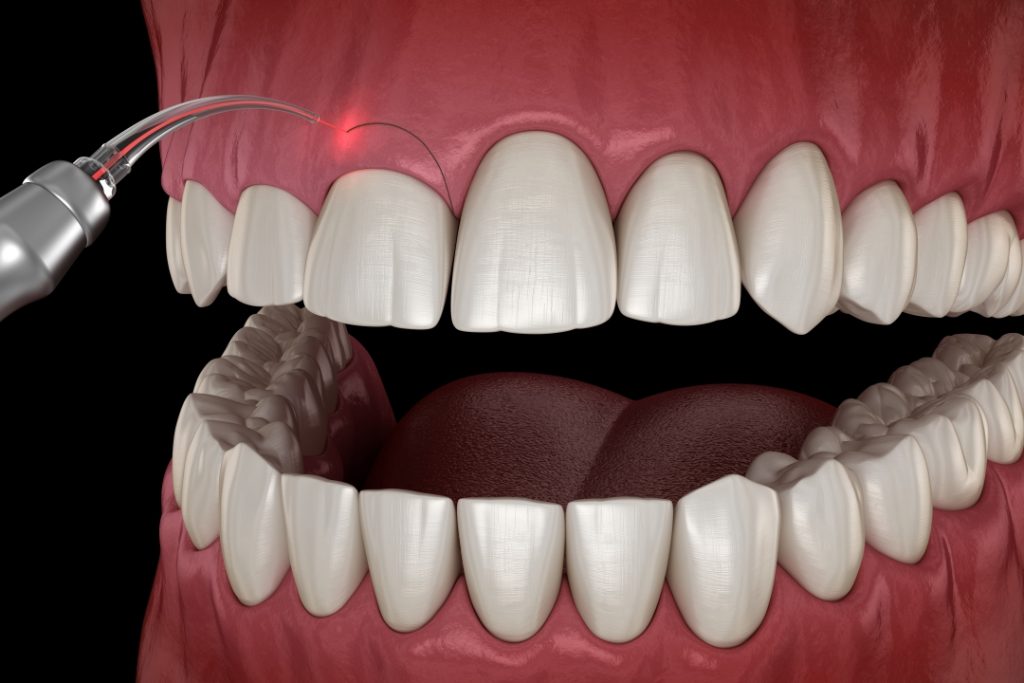Periodontal disease (more commonly referred to as gum disease), affects many people living in America today. When it becomes too advanced for common dental procedures, including scaling and root planing, another treatment option is gingivectomy. This is one of the treatments that counter the effects of gum disease and is recommended for many of our patients.
This procedure is also used for cosmetic reasons, such as to fix a “gummy smile” to have less gum covering the teeth. In this post, we will be focusing more on gum disease, although the procedure is the same for cosmetic reasons.
To learn more about gingivectomy, read our short guide below.
What Is Gingivectomy?
It is a procedure whereby a portion of the gums are removed from in and around a tooth or teeth. This is to treat gum disease or to lengthen the height and width of one or more of the patient’s teeth. It is performed by a periodontist with training in periodontal surgery. At Arizona Periodontal Group, this is Dr. Ariel Trujillo.
Who Is A Candidate For Gingivectomy?
If you have gum disease, Dr. Trujillo may recommend the procedure to prevent further damage.
Signs of gum disease include:
- Red or swollen gums
- Tender or bleeding gums
- Loose teeth
- Sensitive teeth
- Persistent bad breath
Another sign of gum disease is gingivitis, which is inflammation of the gums. This condition, often caused by poor oral hygiene, can also result from abrasive brushing and the natural effects of aging. If untreated, gingivitis can develop into periodontitis exposing the root of your tooth (or teeth) and this can result in sensitivity and pain. It can also result in tooth loss.
If Dr. Trujillo spots any signs of these issues in your mouth, he might recommend a gingivectomy to you. This will prevent the risk of any further problems associated with gum disease. Such problems can include damage to your jaw, tooth loss, and further risks associated with your overall health and well-being.

Do You Have Questions?
To see if you are a candidate for a gingivectomy or to simply ask questions about the procedure, schedule an appointment with Dr. Trujillo today.
How Gingivectomy Is Performed
The procedure takes between 30-60 minutes to perform, depending on how much of the gum tissue needs to be removed. A minor procedure involving one or several teeth will usually take a single session. Where major gum removal or reshaping is needed, several visits will be recommended, as healing will need to take place before the procedure continues.
Many patients are worried about pain and discomfort during the procedure, but there is no need to fear. Local anesthetic and other sedation are options by Dr. Trujillo and his team, so you will be kept as comfortable as possible.
Before the procedure, Dr. Trujillo will determine how much tissue will need to be removed or added during the operation. He will show you what he plans to do before beginning the procedure to ensure you are happy with the results. If you have any questions beforehand, please feel free to ask.
The procedure
Dr. Trujillo will explain more about the procedure during your appointment. However, here is a short guide on what to expect.
- You will receive a local anesthetic to numb the gums in the affected area.
- Dr. Trujillo will use a surgical tool to trim and remove pieces of gum tissue.
- During the procedure, a suction tool will remove any excess saliva.
- Once the tissue has been removed, Dr. Trujillo will use a surgical tool to vaporize any remaining tissue and reshape the gum line.
- The remaining gums will be reattached in and around the tooth using stitches.
- The affected area will be cleaned with saline and special rinses.
After the procedure is complete, Dr. Trujillo will place a surgical dressing in and around the teeth and gums. This should be left in place for about a week to aid the healing process. You may need to replace it at home, but don’t worry, instructions will be given.
Recovery And Aftercare
After the procedure, you will likely experience some swelling and bleeding. This is perfectly normal, but Dr. Trujillo will give you advice on how to hurry along the healing process. After a few hours, you will also feel a little pain after the anesthetic has worn off. Again, this is normal, and over-the-counter medication will help ease the pain.
You should be able to go home right away, as only local anesthesia will have been used. However, if you need to rest after surgery or require assistance getting home, please let our team know.
As suggested, you will need to change your bandages and dressings yourself, but Dr. Trujillo and his team will explain how to do this before you leave for home. If you’re still unsure about the instructions you have been given, call the practice for further help.
For the first 24 hours after the procedure, avoid brushing, flossing, and rinsing your mouth. After this initial period, you may resume your normal dental routine in the areas of your mouth unaffected by the gingivectomy. After 48 hours, saltwater rinses to keep your gums clean and to help them heal faster.
During the first week of recovery, avoid touching the affected area. This means no touching with your fingers or tongue, and no straining your mouth open to have a look at it.
Dr. Trujillo will check on your progress with further dental appointments. These will likely be every 3 months or so, and then a twice-yearly health visit to check and clean around the surgical site.
Get In Touch
Have you spotted the signs of gum disease or would simply like to remove extra gums to improve your smile? If so, contact Dr. Trujillo and his team today. In the case of gum disease, before the problem can get worse, a gingivectomy is a possible recommendation to treat infected areas. Get in touch to schedule an appointment, and let us know if you have any further questions about the procedure.






